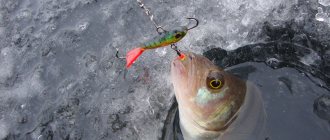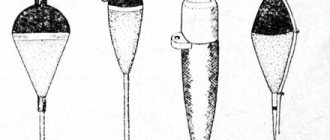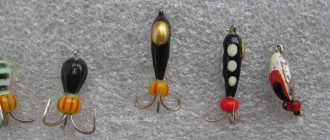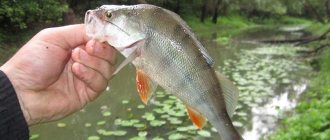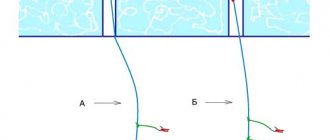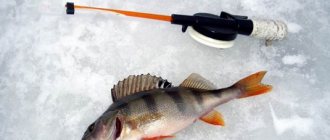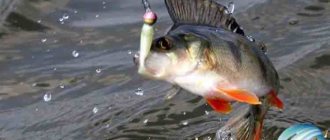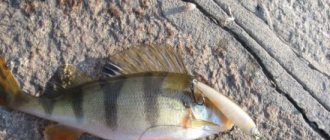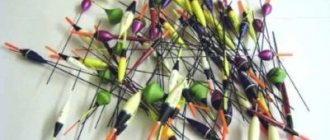Winter fishing is a hobby for millions of people, and each of its fans tries to come up with something new, somehow diversify ice fishing, and contribute to the common cause. Previously, fishermen could only offer the fish a hook with a bloodworm and a jig, then, thanks to fishermen’s imagination, rollers, garlands, drachiki and other cunning designs appeared, and now fishing with a balancer - a miniature artificial fish equipped with hooks on both sides - is in fashion.
Today there is already a large caste of fishermen, who are jokingly called balancers. The equipment of a winter fishing rod for fishing with a balance beam is aimed exclusively at predators. To effectively fish with it, you need to have certain skills. It is equally important to correctly assemble the tackle, which differs significantly from the usual balalaika for fishing for roach and small perch. What kind of fishing rod is needed for fishing with a balance beam in winter? Let's look at the tackle in detail.
Fishing rod
When buying a fishing rod for fishing with a balancer, first of all you need to pay attention to its strength, convenience, reliability of fastening the rings and the build quality in general. Carbon fiber is considered the ideal material for a whip. It is light and clear, unlike plastic, it does not become “wooden” in the cold and does not crack. It can only break if there is a large temperature difference, so you can’t immediately put a load on it. When leaving the car, it is better to wait about ten minutes until it cools down, and then start fishing.
The flexibility of the fishing rod is selected taking into account the weight of the bait. For example, if you intend to use small Rapala balancers, then it is advisable to choose a softer model for them. A rigid fishing rod almost does not bend when lifting a light bait upward, which is why it acquires an excessively frisky game. Sometimes this is good, but most of the time, smooth animation is effective.
Which line to choose for winter fishing with a balance beam?
Incorrectly selected fishing line leads to the following problems:
- Poor performance of the bait due to incorrectly selected thickness and extensibility;
- Fish repellent;
- Inconvenience due to freezing in the cold;
- Breaks due to a hard grip, hook or sharp hook of a pike perch;
- Entanglement.
Some fishermen use braid, citing its strength and lack of stretchability. The wattle becomes tanned in the cold, freezes heavily, and freezes on the reel, blocking unwinding. Experienced spinners say that in winter you should use only monofilament fishing line. Both regular monofilament and fluorocarbon will do.
There are mostly negative reviews on the use of modern advertised nanofil on fishing forums. Nanofil requires careful use and special knots; the surface of such a thread is injured when cleaning from frozen ice, after which it becomes weak and easily breaks at the slightest jerking load. Next, we will consider what kind of winter fishing line for the balancer you need to install when equipping your fishing rod.
Coil
All existing types of reels are applicable for such gear: inertial, inertial-free, multiplier. Each of them has certain advantages and disadvantages, so the choice should be approached seriously and responsibly:
Inertia coil. The main advantage is the open drum, which allows you to visually control the supply of fishing line and ensure that loops and knots do not form on it. If desired, you can choose a mechanism equipped with a ratchet brake and a line release key. The size of the reel should not be unreasonably large, the inner diameter of the drum should not be more than 70 cm. A small winter fishing rod does not need extra weight.- Inertia-free. It’s not for nothing that this reel is called a meat grinder. It really “threshes” and works flawlessly, but in winter it will require special winter lubricant. A huge advantage of inertia-free fishing is that you can take several removable spools with fishing line of different diameters for fishing and quickly change them if necessary.
- Animator. It goes harmoniously with a winter fishing rod, but costs an order of magnitude more. To save money, you can order a Chinese product online, but the correctness of this choice is highly questionable. A cheap reel can present an unpleasant surprise, namely, jamming while landing a trophy fish. As a rule, in this case a break occurs. Another disadvantage of the multiplier is limited access to the spool.
How does the tackle for fishing with a balance beam work?
Fishing rod
Its basis is the fishing rod, on which all other elements of the tackle will be placed in one way or another. It must be durable and at the same time capable of absorbing the jerks of this strong fish. The recommended length of the fishing rod (excluding the handle) should be between 30-60 cm. This will allow you to create an effective action of the bait, as well as absorb the jerks of the pike during biting and fishing.
Coil
Reels are most often used inertialess, less often multiplier ones with a friction brake, of medium size. When hit by a large pike, the fishing line may not be able to withstand it, so a properly adjusted clutch is what will save you from an annoying break or slip.
The shock-absorbing properties and resistance to freezing of the fishing line give it undeniable advantages over braided line. It will smooth out the jerks of the fish during the fight against the toothy predator; you just need to take the necessary precautions, avoiding cutting it on the edges of the hole. However, this can be avoided by using fluorocarbon, which is more resistant to abrasion in the cold. The optimal diameter of the fishing line is 0.25 mm
Leash
Using a leash when catching this toothy predator is mandatory. Her sharp teeth have deprived more than one fisherman of a well-deserved trophy. Many of them prefer to make them themselves from guitar strings (size No. 1-2), without skimping on high-quality swivels and carabiners. If we are talking about buying ready-made ones, then you should pay attention to trusted manufacturers. A damaged leash must be promptly replaced with a new one, otherwise the game of the balancer may be hopelessly ruined.
After the angler has chosen and purchased a high-quality fishing line, swivels, fishing rod and other elements of gear, it is time for installation. It happens in the following order:
- A fishing line is tied to the reel and wound in an amount of 20-25 meters. This will be enough, taking into account the depths of the home pond and the likelihood of cutting off the fishing line after it receives damage from the edges of the hole.
- The most powerful whip is installed (if it is possible to install replaceable whips).
- A nod is put on the whip.
- A fishing line is threaded through the hole on the whip and nod.
- A fastener is attached to the threaded fishing line.
- A clasp attached to the fishing line is attached to the balancer.
Well, now the winter fishing rod is assembled, you can start fishing.
For winter fishing with a balance beam, you need clearly tuned gear, depending on the weight of the bait and the depth of fishing. A fishing rod for fishing with balance beams needs to be elastic in order to feel the game. At the same time, a very soft fishing rod that falls through when swung is not suitable. The golden mean is chosen. To fish at depth with heavy bait, you will need a fairly powerful but sensitive fishing rod equipped with a reel.
The equipment when fishing with balance beams in winter also depends on the size and depth. So with any installation components:
- Correct selection of fishing rod flexibility.
- Choosing fishing line for winter fishing with balance beams.
- Correct tying of the bait and its position in the water.
- Equipping the rod with a nod (if necessary).
About what fishing line to use for winter fishing with balance beams.
The matter does not end with just choosing a bait. Winter fishing with a balance beam can leave an unpleasant impression if, for example, in the midst of fishing, the fishing rod suddenly breaks. Tackle plays as important a role as the bait itself, so you should select it in advance. You need to think about buying a suitable fishing rod. In addition, high-quality winter fishing rod equipment for fishing requires a scrupulous selection of reel and fishing line.
Fishing rod
A balancer rod starts with determining the material. Winter fishing dictates its own rules, one of which recommends avoiding the purchase of plastic fishing rods. It’s all about the temperature, which only the most durable solutions can withstand, so it’s better to pay attention to carbon fiber. It is known for its reliability, which it regularly proves by withstanding the most severe frosts. Tools made from this material, unlike their plastic counterparts, do not become woody or crack.
In addition to the material, it is worth considering the flexibility of the fishing rod. It is customary to work with this parameter after selecting the bait. For example, lightweight equipment is recommended to be used in combination with highly flexible, soft solutions, as they ensure a smooth movement of the artificial fish. In such cases, the heavy ones play more harshly, which scares away predators. The heavier the bait, the heavier the tool.
A winter rod for fishing with a balancer is used both with and without a nod. Disagreements between fishermen on this issue will not subside. Its installation is supported by the cautious winter bite, which is impossible to recognize without a nod. Experienced anglers advise setting a hard nod. However, the weight of the equipment is much more important.
We suggest you familiarize yourself with How to properly form a rose bush for the winter
When choosing a fishing rod, it is also worth checking its durability and overall build quality. All parts must fit tightly together. Creaking, swaying of individual parts, poorly secured rings should not be allowed under any circumstances. After making the final decision, you can move on to the next stage - equipping the fishing rod for fishing with a balancer.
Coil
The equipment gives the angler freedom in choosing a reel. There are three types of possible solutions:
- Inertial. Such a reel is distinguished by the ability to visually assess the remaining line, its reserve, and, accordingly, manually control the occurrence of knots or loops. Additionally, you can choose a reel with a brake and a line release button. When choosing, it is better not to follow the “bigger is better” principle, because a small-sized winter fishing rod does not tolerate increased weight. The diameter of the drum should not exceed 70 cm.
- Inertialess. This reel is considered the most popular among both experienced anglers and beginners. It has a complex design, but remains comfortable to use, has a soft stroke, high winding speed and a reverse stopper. The reel looks solid and its handle feels good in the hand. In addition, the spinning reel can be changed while fishing, adapting to the prey.
- Multiplier. This reel stands out from its competitors due to its versatility, which allows for the use of baits of any weight, high stability and sensitivity. In addition, it does not twist the line, unlike its predecessors. However, it was not without its drawbacks. This type of reel is distinguished by its high price, justified by the complexity of the design, the need for regular maintenance and limited access to the spool.
A fishing line can either save a failed fishing trip or completely ruin it. When choosing, you have to take into account all factors: weight of equipment, strength, thickness, diameter, air temperature, installation. You can immediately stop using braided fishing line. It freezes over due to its structure, as a result of which the angler is forced to remove ice from it almost after every lift, which, by the way, also gets on the fastening rings. Braid is good only in fast currents, as it does not stretch and allows the owner to better control the game.
Winter fishing lines should be extremely thin within the limits of the bait used. This decision is justified by the peculiarity of winter fishing. Transparent cold water does not limit the predator’s view, which is why he can notice the play of the fishing line in the light and suspect something is wrong. Thick fishing lines have a negative impact on the game, making it more abrupt and choppy.
The diameter is calculated taking into account the weight of the bait and the expected catch. The shorter the line, the lower the load it can withstand. Trophy fishing involves using fishing line from 0.14 to 0.18 mm. When purchasing gear, you also need to take care of its resistance to the effects of stones, shells and ice.
The balancer for winter fishing is equipped with a ring for tying a fishing line. Well-known fishing knots are suitable for fastening:
- Palomar:
- The fishing line folded in half must be pulled through the fastening ring.
- Then you need to tie a regular knot, which forms a loop of double fishing line.
- An artificial fish is threaded through the loop.
- The knot is carefully tightened and excess fishing line is removed.
- Clinch:
- The fishing line is threaded through the fastening ring of the bait.
- The short end of the fishing line is wrapped around the main line 7 times.
- The end of the fishing line is threaded through the formed loops.
- The knot is slowly tightened.
Balancers
The task of the balancer is to interest the predator, provoke it to attack, and for this it must at least play interestingly and believably imitate a live fish. Some winter fishermen do not trust factory products, so they make such bait themselves. But with today's diversity, this is not particularly necessary. In fishing stores you can find a variety of balancers: plastic, silicone, narrow-nosed, with an enlarged head, with soft feathers, with a stabilizer, combined. Let's look at the three most common types:
The classic balancer with a triangular feather is a perfectly balanced bait. Working position – horizontal (deviation of 5 degrees is allowed). The nature of the animation largely depends on the shape of the nose (front).- A balancer with a soft tassel tail is a perch option, although bites from pike perch and pike are also possible. Most often used in shallow waters to catch small striped predators. With a sharp swing, this type of balancer can turn upside down, so a calmer and smoother play is recommended for it.
- A silicone balancer is a specific bait that helps out on days when the fish are inactive. They need to play the same way as with a jig. A slow rise with a slight tremor will stir up any sleepy predator.
Balancers rating
If you want to increase your chances of successful fishing with a balancer, then you should have a couple dozen different balancers. They should differ both in size and color.
The best companies are Rapala and Kuuasamo. But they are quite expensive, but their effectiveness has been proven by many fishermen.
But there are also cheaper, but less successful options for balancers from.
It is recommended to equip the balancer tees with colored cambrics.
The dimensions of the balancer should be numbers 3 and 5.
The paysite is just next to the dacha. And I have something to promote.
Kanfighter
fd8080
Kanfighter
I fished in the same team with such a famous fisherman as Uncle Kolya Rozhkov. So, he didn’t worry about this at all and always set 0.2mm on his spinners. And he caught it well. And the thickness of the line for a spinner is oh so important than for balance.
photo of a perch with a torn off balance beam.
Attachments
fd8080
I fished in the same team with such a famous fisherman as Uncle Kolya Rozhkov. So, he didn’t worry about this at all and always set 0.2mm on his spinners. And he caught it well. And the thickness of the line for a spinner is oh so important than for balance.
photo of a perch with a torn off balance beam.
Kanfighter
fd8080
bleak
Attachments
Mike13
ihtiander33
bleak
First place for prostitution! And a quarterly reward from the modders.
———- Message added at 21:24 ———- Previous message posted at 21:23 ———-
The paysite is just next to the dacha. And I have something to promote.
———- Message added at 21:33 ———- Previous message posted at 21:24 ———-
chill
bleak
Leon 116
I went the same way. I also use fluor, the strength, stretchability is minimal, almost non-existent, invisible, does not get tangled - this is all very important. One of my friends, having switched from regular fishing line to fluorine, felt the difference just as strongly, as he says, “I feel every fart of the pike perch.”
PS: no one thought about the fact that the large windage of the fluor also plays a positive role, it makes the animation softer and smoother.
chill
Now the price of mid-price fluor with a reel of 30-50 meters is not much more expensive than a skein of high-quality monofilament, believe me, I am working in this direction. Therefore, do not believe in fairy tales about new super-duper technologies in the production of fishing lines and fluorocarbons, in most cases we are talking about unfounded overpricing by the Russian distributor.
———- Message added at 23:35 ———- Previous message posted at 23:27 ———-
Leon116 I agree, the same situation when twitching a minnow, many times I got caught when it doesn’t take the line, but on a mono with the same wobbler, bite follows bite.. What diameters do you mainly use in Tatarstan?
Pike on the balancer on the last ice
When oxygen-enriched meltwater gets under the ice, the activity of pike increases. The bulk of pike begin to move from deep to shallow water. On the last ice, promising places are sharp changes in depth with shelters (submerged stumps, snags), and stream mouths. At the end of winter, the predator experiences a pre-spawning feast. The pike bite begins before sunrise and can continue throughout the day. The technique for catching pike on a balance beam on the last ice is the same as on the first.
In conclusion, I would like to add that regardless of the winter period (dead winter, first/last ice), the fisherman has to select the desired pace of play and bait throughout the fishing in order to increase the number of bites. After all, a pike’s “mood” can change throughout the day, for example, due to changes in weather or water level. There are hours in which she eats very greedily, and at other times she does not pay attention to the “food” at all. Often a good bite lasts only a few minutes, after which there is a long “silence”.
Published: December 01, 2021, 13:40
- Tags:
- balance
- winter fishing rod
- pike
Types of balancers for perch
All existing balancers used for perch fishing can be divided into two types:
- Tumbling. Used for fishing at shallow depths.
- Unfolding. This type is used in deep areas of the reservoir.
The differences lie in the design features. The animation changes depending on the shape of the bait. In tumbling-type balancers, the front part stands out and because of this, the bait tumbles during retrieving. Unfolding type baits, when performing a retrieve, make a loop, turn around and perform a figure-eight movement.
Catching pike on the first ice on a balance beam
When freeze-up sets in, the pike does not immediately actively bite; it takes some time for it to get used to the new conditions for it - a reservoir covered with ice. Therefore, according to the first ice, the peak pike bite is observed not at a time when the ice has just reached a thickness of 5 cm, but when its thickness is already 8–12 cm.
As a rule, small bodies of water - ponds, lakes, quarries - are the first to become covered with ice. Actually, winter ice fishing begins with them. However, the activity of pike in the reservoirs listed above does not last long, about two weeks. On large reservoirs and rivers, a good bite on first ice can last up to a month or more.
According to the first ice, pike should be looked for in areas of the reservoir with shallow depth near some kind of shelter - along aquatic vegetation, in snags, etc. Areas near where streams flow into a body of water may be promising. When searching for pike, holes are made in series of several, five to six meters apart. When fishing, you need to be as quiet as possible. At the very beginning of the first ice, the pike is very timid, especially in shallow water areas, it is afraid of the trampling of feet, blows of an ice pick, etc.
The sludge is not removed from the holes so that as little light as possible penetrates under the ice. To lower the bait, the slush is pierced with a stick. Having drilled about a dozen holes or more, they begin fishing from the first hole, alternately fishing the next ones. If there are no bites in one hole within 2 minutes, move on to the next one. Usually an active pike manifests itself immediately. As a rule, during the first ice, when there is no bite for a long time, they do not linger at this place and move on to the next one.
But if they are sure that there is definitely a pike here, then they try to re-fish the holes, changing the balancer to a different size (put it either smaller or larger). If unsuccessful, they also try to catch with other colors. As for the technique of fishing with a balance beam, a general example is given in the link above, at the very beginning of this article. It remains only for this balancer model to determine a more accurate pause time after swinging the whip.
When fishing at shallow depths (1 - 1.5 m), the strokes should be short and quite sharp (but not too sharp). In this case, the duration of the pause is minimal, 2 – 4 seconds. When fishing at depth, the swings of the whip can be made higher, alternating with short swings. With a large swing, the trajectory of the bait to the starting point will be longer, so the pause after the swing should be longer, 5 - 8 seconds or more. The pause time depends not only on the height and strength of the swing, but also on the model of the balancer.
By the way, the moment the pause ends can be determined by the fishing line. When, after swinging the fishing rod, the fishing line above the hole stops moving and takes a stably perpendicular position relative to the water in the hole, this means that the balancer has completed its “loop” and returned to its starting point. Then make the next swing and so on until you bite or change holes. An active pike grabs a moving bait, so there is no point in fishing with a stationary balancer.
Pike bites on the first ice are well transmitted to the hand; during this period it is not necessary to equip the whip with a nod. When biting, the pike can even tear the fishing rod out of the angler’s relaxed hands, so don’t relax too much. Since pike fishing takes place near drowned trees, branches, reeds, grass, etc., you must have an unhooking hook with you. Otherwise, you risk being left without balancers.
The best bite is most often observed in cloudy weather and when the ice is covered with snow. Pike bites occur in the morning, afternoon, and evening. On frequently visited lakes, the best pike bite can only be in the evening. The noise created by the army of fishermen takes away the toothy appetite during the day. And in the evening, when the fishermen go home, the pike goes hunting.
Catching pike on a balance beam in the middle of nowhere
By mid-winter, the pike moves from shallow water to deeper parts of the reservoir - deep edges, dumps, exits from holes, etc. In the dead of winter, fish are searched for in areas with the best oxygen conditions. The most promising places are where springs flow from the bottom. With the deterioration of the oxygen regime during the period of deep winter, pike bites occur less and less often, and it does not take as greedily as in the first ice.
It begins to peck only on sluggishly playing small baits. A sweeping game is not only unattractive for a predator, but can also scare her away. It gets to the point that the pike gets caught on jigs (usually on devils, see Fishing on Chertik), and gets caught on the edge of the lip. At such moments, the toothy fish is caught without using an anti-bite leash. The gear used is more delicate - smaller balancer, thinner fishing line. In order not to miss a bite from a sleepy pike, install a nod on the fishing rod. The bites are no longer as fast as in the first ice.
The game comes down to sluggish and smooth movements of the bait. When playing this way, the balance bar does not make looping movements, but only swings forward/backward. Pauses are made longer. A bite even happens when the fishing rod is simply held in the hand without making any movements. Although in fact, at this time the balancer still moves slightly from the “trembling” hand of the fisherman.
You can also try fishing with a balancer, like a jig, making a slight vibration with the tip of the fishing rod. In the dead of winter, it takes more time to fish holes than on the first ice. The pike can simply stand and look at the bait for some time before deciding to grab it. During this difficult period of winter, pike move little around the reservoir. Sometimes she doesn’t even want to swim a couple of meters to the intended prey.
Therefore, when searching for fish, holes are drilled closer, 1 - 1.5 m from each other, in order to present the bait right “under the nose” of the predator. It is best to fish during the thaw, when fish activity increases. In large rivers, fish are more or less active all winter, since there is no such strong deterioration in the oxygen regime as in stagnant and low-flow reservoirs.
